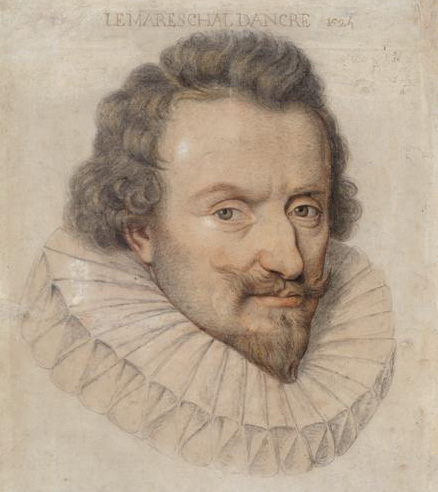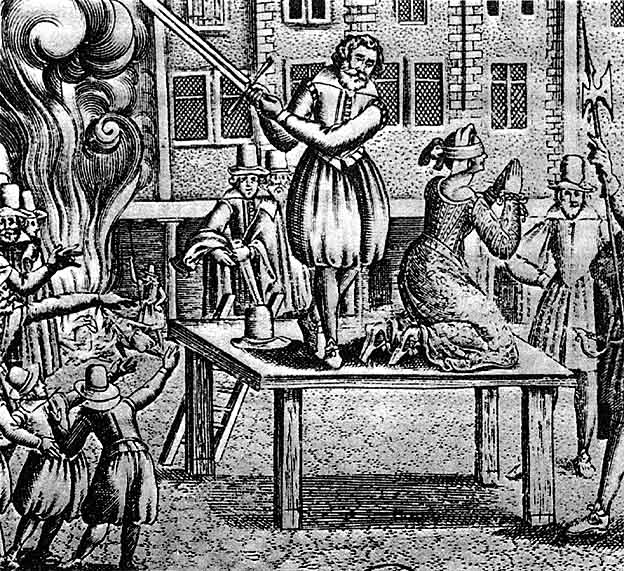by Susan Flantzer
© Unofficial Royalty 2023
Favorite: a person treated with special or undue favor by a king, queen, or another royal person
Leonora Dori Galigai and later, her husband Concino Concini, were favorites of Marie de’ Medici, Queen of France, the second wife of Henri IV, King of France. Neither Leonora nor Concino had a happy ending.
Leonora Dori Galigai; Credit – Wikipedia
The daughter of Jacopo di Sebastiano Dori and Caterina Dori, Leonora Dori Galigai was born on May 19, 1568, in Florence, then in the Grand Duchy of Tuscany, now in Italy. Her father was a carpenter and her mother was a wet nurse at the court of the Medicis who were Grand Dukes of Tuscany from 1569 to 1737. Jacopo was able to buy the adoption of his children by the Galigai family, a poor but noble Florentine family from which he was descended in the female line. This gave his children some advantages socially and politically.
Leonora had two brothers and one sister:
- Andrea Dori Galigai
- Sebastiano Dori Galigai, Archbishop of Tours (? – 1694)
- Cassandra Dori Galigai
In 1588, Ferdinando I de’Medici, Grand Duke of Tuscany appointed twenty-year-old Leonora to be the maid to his thirteen-year-old niece Marie de’ Medici. Having lost her mother at the age of five, and her father at the age of twelve, Marie was raised by her uncle Ferdinando, who had succeeded her father as Grand Duke of Tuscany. For nearly thirty years, Leonora remained in service to Marie, becoming her close friend and confidante. In late 1600, when Marie traveled to France to become the second wife of Henri IV, King of France, Leonora was included in her retinue as lady-in-waiting and wardrobe attendant.

Leonora’s husband Concino Concini; Credit – Wikipedia
Also in Marie’s retinue was Concino Concini, whose father was First Secretary to Marie’s uncle. During the journey to France, Concino romanced Leonora and proposed to her. King Henri IV opposed the marriage because he considered Concino to be too ambitious but he finally gave his approval, and Leonora and Concino were married on July 12, 1601. Marie de’ Medici, now Queen of France, gave Leonora a large dowry. In 1605, Concino became maître d’hôtel (chief steward) of Queen Marie’s household, and in 1608, he received the additional appointment of premier écuyer of the queen, being in charge of her royal stables. These positions allowed Concino to amass a small fortune, which he invested in real estate.
Leonora and Concino had two children, named after King Henri IV and Queen Marie:
- Henri Concini (1603 – 1631), died of the plague
- Marie Concini (1607 – 1617), died in childhood
In 1610, King Henri IV was assassinated and Queen Marie was appointed Regent for their eldest son, the eight-year-old King Louis XIII of France. Leonora exploited her friendship with Queen Marie, encouraging the rapid rise of her husband’s career. Concino became Queen Marie’s most trusted advisor. He was created Marquis d’Ancre and a Marshal of France. Leonora and Concino successfully plotted to have King Henri IV’s very capable Chief Minister, Maximilien de Béthune, Duke of Sully dismissed. Queen Marie was strongly influenced by Concino and Leonora and many of her policies were in sharp contrast to those of her late husband. Concino and Leonora hoped to influence the suppression of Protestantism in France. However, Queen Marie, as Regent, maintained her late husband’s policy of religious tolerance. As one of her first acts, Marie reconfirmed Henri IV’s Edict of Nantes, which ordered religious tolerance for Protestants in France while asserting the supremacy of the Roman Catholic Church.
The behavior and policies of Concino and Leonora caused hatred among the French people. The French nobility had to deal with their power being weakened because Concino and Leonora’s Tuscan followers were given preference in the awarding of positions and privileges. The French common people resented the power of these Tuscans who had become masters of France.

A contemporary depiction of the assassination of Concino Concini; Credit – Wikipedia
Finally, sixteen-year-old King Louis XIII, who detested Leonora and Concino, stepped up and asserted his position as King. In April 1617, he organized a coup d’état with Charles d’Albert, Duke of Luynes, a close advisor and favorite of King Louis XIII from childhood until his death, who held numerous top positions within the French court. Since Concino could not be arrested because he had a personal army of more than 7,000 soldiers, it was planned to have him assassinated. On April 24, 1617, Concino Concini was killed in the courtyard of the Louvre Palace in Paris. He was buried at the Church of Saint-Germain-l’Auxerrois in Paris but an angry crowd of Parisians exhumed his body and dragged it through the streets of Paris. After being stoned and beaten, Concino’s body was hanged by the feet from a gallows, and then dismembered and burned.

17th-century engraving of the execution of Leonora; Credit – Wikipedia
After the death of her husband, the tides also turned against Leonora. She was arrested, accused of witchcraft, and sent to the Bastille. Queen Marie was unable to help her old friend because she had been sent into exile at the Château de Blois in the Loire Valley on the orders of her son King Louis XIII. After a short trial, Leonora was found guilty of having bewitched Queen Marie, Regent of France. On July 8, 1617, at the Place de Grève in Paris, now the Place de l’Hôtel-de-Ville, Leonora was beheaded, and then her headless body burned at the stake.
This article is the intellectual property of Unofficial Royalty and is NOT TO BE COPIED, EDITED, OR POSTED IN ANY FORM ON ANOTHER WEBSITE under any circumstances. It is permissible to use a link that directs to Unofficial Royalty.
Works Cited
- Leonora Doria Galigai. geni_family_tree. (2016). https://www.geni.com/people/Leonora-Doria-Galigai/6000000022782162100
- Mehl, Scott. (2016). Marie de’ Medici, Queen of France. Unofficial Royalty. https://www.unofficialroyalty.com/marie-de-medici-queen-of-france/
- Wikimedia Foundation. (2023). Leonora Galigaï. Wikipedia (German). https://de.wikipedia.org/wiki/Leonora_Galiga%C3%AF
- Wikimedia Foundation. (2023). Leonora Dori. Wikipedia. https://en.wikipedia.org/wiki/Leonora_Dori
- Wikimedia Foundation. (2022). Leonora Dori Galigai. Wikipedia (Italian). https://it.wikipedia.org/wiki/Leonora_Dori_Galigai
